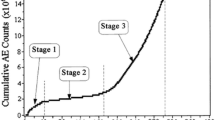Abstract
Nucleation of microcracks can be detected and analyzed by acoustic emission (AE), by which crack kinematics of locations, types and rientations are quantitatively estimated. The procedure was applied to clarify mechanisms of corrosion cracking. Based on fracture mechanics, numerical analysis was conducted by the boundary element method (BEM). Relations between the stress intensity factors and crack types were investigated by BEM solutions. In experiments, four types of crack patterns were nucleated by employing expansive agent. Following the surface crack, the diagonal crack and/or the horizontal crack propagated. The internal crack extended after the surface crack was terminated. Depending on the crack types, contributions of mode-I and mode-II were varied. According to AE results, four crack patterns observed differently consisted of tensile, mixed-mode and shear cracks. It is demonstrated that mechanisms of corrosion cracking in concrete are dominantly of mode-I failure along with a minor contribution of mixed-mode and mode-II.
Similar content being viewed by others
References
M. Ohtsu T. Okamoto S. Yuyama (1998) ArticleTitle‘Moment tensor analysis of acoustic emission for cracking mechanics in concrete’ ACI Struct. J. 95 IssueID2 87–95
M. Ohtsu M. Shigeishi (2002) ArticleTitle‘Three-dimensional visualization of moment tensor analysis by SiGMA-AE’ e-J. Nondestructive Test. ISSN 7 IssueID9 1435–4934
A.K.M. Farid Uddin M. Ohtsu (2002) ArticleTitle‘BEM analysis of mixed-mode crack propagation due to corrosion of reinforcement in concrete’ J. Mater. Concrete Struct. Pavements, JSCE 55 IssueID(704 271–280
M. Ohtsu Y. Kaminaga C.M. Munwam (1999) ArticleTitle‘Experimental and numerical crack analysis of mix-mode failure in concrete by acoustic emission and boundary element method’ J. Construct. Build. Mater. 13 IssueID1–2 57–64 Occurrence Handle10.1016/S0950-0618(99)00008-2
Smith, R.N.L. and Mason, J.C., ‘A Boundary element method for curved crack problems in two dimensions’, in: Boundary Element Methods in Engineering, Springer-Verlag, Berlin, (1982) pp. 472–484.
Erdogan, F. and Sih, G.C., ‘On the crack extension in plates under plane loading and transverse shear’, J. Basic Eng. (12) (1963) 519–527.
A. Carpinteri (1986) Mechanical Damage and Crack Growth in Concrete Martinus Nijhoff Publishers Dordrecht, The Netherlands Occurrence Handle0635.73108
A.K.M. Farid Uddin M. Ohtsu (2002) ArticleTitle‘Application of AE to fracture toughness and crack analysis by BEM in concrete’ e-J. Nondestructive Test ISSN 7 IssueID9 1435–1934
M. Ohtsu S. Yoshimura (1997) ArticleTitle‘Analysis of crack propagation and crack initiation due to corrosion of reinforcement’ J. Construction Build. Mater. 11 IssueID7-8 437–442 Occurrence Handle10.1016/S0950-0618(97)00020-2
Author information
Authors and Affiliations
Corresponding author
Rights and permissions
About this article
Cite this article
Uddin, F.A.K.M., Shigeishi, M. & Ohtsu, M. Fracture Mechanics of Corrosion Cracking in Concrete by Acoustic Emission. Meccanica 41, 425–442 (2006). https://doi.org/10.1007/s11012-006-0004-9
Received:
Accepted:
Issue Date:
DOI: https://doi.org/10.1007/s11012-006-0004-9




